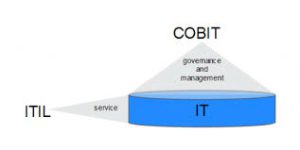COBIT vs ITIL: A Real-Life Example of What These Two Can Do.


Contemplating the implementation of IT Service Management (ITSM) and feeling uncertain about the suitable framework? In this exploration, we aim to assist you by drawing a real-life comparison between ITIL and COBIT within an enterprise context. Before delving into practical assessments, let’s take a moment to understand the theoretical distinctions between COBIT and ITIL.
Unveiling the Dynamics: ITIL vs COBIT – Navigating the Differences
Introduction: Embarking on the journey of optimizing IT Service Management (ITSM) often leads organizations to a crucial crossroads: choosing the right framework. In the realm of IT governance, two prominent contenders, ITIL (Information Technology Infrastructure Library) and COBIT (Control Objectives for Information and Related Technologies), stand out. This blog post dives into the intricacies of ITIL vs COBIT, shedding light on the distinctions that can guide organizations towards informed decision-making.
Understanding the Foundations: Before delving into the divergences, let’s establish a foundational understanding of ITIL and COBIT.
ITIL: ITIL, a comprehensive framework, is renowned for its service-centric approach. It delineates a set of best practices for IT service management, focusing on delivering value to customers through quality service delivery and continual improvement.
COBIT: On the other hand, COBIT is a framework developed by ISACA, concentrating on IT governance and control. COBIT provides a structured approach to aligning IT goals with overall business objectives, emphasizing risk management, regulatory compliance, and efficient control mechanisms.


Exploring the Differences:
-
Focus and Scope:
- ITIL: Primarily concentrates on the end-to-end service lifecycle, emphasizing service strategy, design, transition, operation, and continual service improvement.
- COBIT: Puts a strong emphasis on governance and control, aiming to ensure that IT processes align with business goals, mitigate risks, and comply with regulatory requirements.
- Process vs. Control:
- ITIL: Centers around defining and refining processes to enhance service delivery, with a focus on efficiency and customer satisfaction.
- COBIT: Prioritizes control objectives and IT governance, emphasizing the establishment of policies, procedures, and monitoring mechanisms.
- Flexibility vs. Rigidity:
- ITIL: Offers flexibility in implementation, allowing organizations to adopt and adapt practices based on their specific needs and contexts.
- COBIT: Provides a more structured and prescriptive approach, ensuring a standardized set of controls for governance and compliance.
Conclusion: In the dynamic landscape of ITSM, choosing between ITIL and COBIT is a pivotal decision. Organizations must carefully weigh their priorities, considering factors such as service delivery, governance, compliance, and risk management. Ultimately, the choice between ITIL and COBIT depends on the unique requirements and goals of each organization. By understanding the nuances of these frameworks, businesses can navigate the ITSM landscape with clarity and confidence.
Under Observation of T4e Automation:
At T4e Automation, the deliberation between COBIT and ITIL unfolds as a strategic exploration tailored to the unique dynamics of the company. In this observant journey, COBIT, with its meticulous emphasis on governance, control, and risk management, emerges as a beacon for navigating the intricate landscape of T4e Automation’s IT infrastructure. The structured framework of COBIT aligns seamlessly with the company’s commitment to precision, offering a comprehensive solution to streamline IT processes, ensure regulatory compliance, and fortify risk resilience. Conversely, ITIL, recognized for its service-centric ethos, beckons with promises of optimizing the end-to-end service lifecycle.
The adaptability of ITIL becomes a key consideration for T4e Automation, allowing the company to tailor best practices to its specific needs, fostering service efficiency, and elevating customer satisfaction. As T4e Automation contemplates this crucial decision, the choice between COBIT and ITIL unfolds not merely as a selection between frameworks but as a strategic alignment with the company’s vision, operational nuances, and commitment to delivering cutting-edge automation solutions.
Here are some of the problems that the company is facing and their COBIT-provided solutions:
The Landscape of Corporate Challenges:
Complex IT Environments:
- Challenge: The rapid evolution of technology often results in complex IT landscapes, making it challenging for companies to maintain operational efficiency and security.
- Solution with COBIT: COBIT provides a structured framework for IT governance, helping organizations streamline and optimize their IT processes. By aligning IT goals with business objectives, COBIT facilitates a cohesive and efficient IT environment.
Regulatory Compliance:
- Challenge: Navigating the ever-expanding landscape of regulations. Poses a significant challenge for companies aiming to ensure compliance and avoid legal repercussions.
- Solution with COBIT: COBIT incorporates a robust control framework, aiding organizations in establishing and maintaining compliance with regulatory requirements. It provides a systematic approach to implementing controls and monitoring processes to meet legal standards.
Risk Management:
- Challenge: Identifying and mitigating risks in an ever-changing business environment is a constant struggle for companies seeking to protect their assets and reputation.
- Solution with COBIT: COBIT places a strong emphasis on risk management, offering a comprehensive set of controls and guidelines. By integrating risk management practices into IT processes, COBIT assists companies in proactively identifying and addressing potential risks.
Aligning IT with Business Goals:
- Challenge: Ensuring that IT initiatives align seamlessly with overarching business objectives can be a daunting task for organizations aiming for strategic cohesion.
- Solution with COBIT: COBIT acts as a bridge between IT and business, providing a framework that aligns IT goals with the strategic objectives of the organization. This alignment enhances the contribution of IT to overall business success.
Here’s how ITIL can solve the problems that IT teams in MN Logistics face and cause;
In the fast-paced realm of logistics, where precision and efficiency are paramount, the role of Information Technology (IT) is indispensable. MN Logistics, like many industry players, faces its share of IT challenges that can impede operations and hinder growth. In this blog post, we’ll explore how the implementation of ITIL (Information Technology Infrastructure Library) can be the game-changer MN Logistics needs to overcome its IT hurdles and usher in a new era of streamlined logistics excellence.
Identifying MN Logistics’ IT Pain Points:
- Service Downtime and Disruptions: MN Logistics grapples with the recurring issue of service downtime and disruptions, impacting the seamless flow of operations. These interruptions not only lead to productivity losses but. Also tarnish the reputation of the company in the eyes of clients and partners.
- Lack of Standardized Processes: The absence of standardized IT processes within MN Logistics creates a scenario where tasks are handled inconsistently. This lack of uniformity not only hampers efficiency but also introduces the risk of errors and miscommunication.
- Inadequate Change Management: Keeping pace with the evolving logistics landscape requires MN Logistics to adapt swiftly to technological changes. However, the absence of a robust change management system often leads to resistance, confusion, and disruptions when implementing new IT initiatives.
How ITIL Can be the Solution:
- Service Lifecycle Approach: ITIL’s service lifecycle approach aligns seamlessly with the logistical needs of MN Logistics. By implementing ITIL practices, MN Logistics can ensure a holistic and well-coordinated approach to service management, from strategy and design to transition, operation, and continual improvement.
- Standardization for Efficiency: ITIL emphasizes the importance of standardizing processes to enhance efficiency. MN Logistics can benefit from adopting ITIL’s best practices. Creating a consistent framework that optimizes resource utilization, reduces errors, and ensures a smoother workflow.
- Change Management Excellence: Addressing MN Logistics’ challenge in embracing technological change, ITIL provides a structured change management process. This ensures that changes are well-planned, communicated effectively, and implemented with minimal disruption. Fostering a culture of adaptability within the organization.
Conclusion:
In the dynamic landscape of IT Service Management (ITSM). Where the convergence of technology and business objectives is paramount, the choice between COBIT and ITIL becomes a strategic cornerstone for organizational success. This exploration has illuminated the theoretical distinctions. Practical applications of these two formidable frameworks, offering a roadmap for businesses navigating the complexities of IT governance.
As organizations contemplate the implementation of ITSM. The COBIT vs. ITIL dilemma is not a binary choice but a nuanced decision-making process. The stark differences in focus, approach. And flexibility between ITIL’s service-centric model and COBIT’s governance and control emphasis provide organizations. With diverse tools to address their unique challenges.
On the other hand, the journey into the logistics realm with ITIL unveils its transformative potential for entities like MN Logistics. The service lifecycle approach proves instrumental in addressing specific pain points such as service downtime. Lack of standardized processes, and the need for change management excellence. ITIL’s emphasis on standardization and adaptability aligns seamlessly with the intricate demands of the logistics industry.
As businesses traverse the complex terrain of ITSM, armed with the insights from this comparison. They are better equipped to make informed decisions. By understanding the nuances of COBIT and ITIL, organizations can embark on a journey that transcends mere IT optimization. Fostering a culture of adaptability, efficiency. And strategic alignment with overarching business goals.
